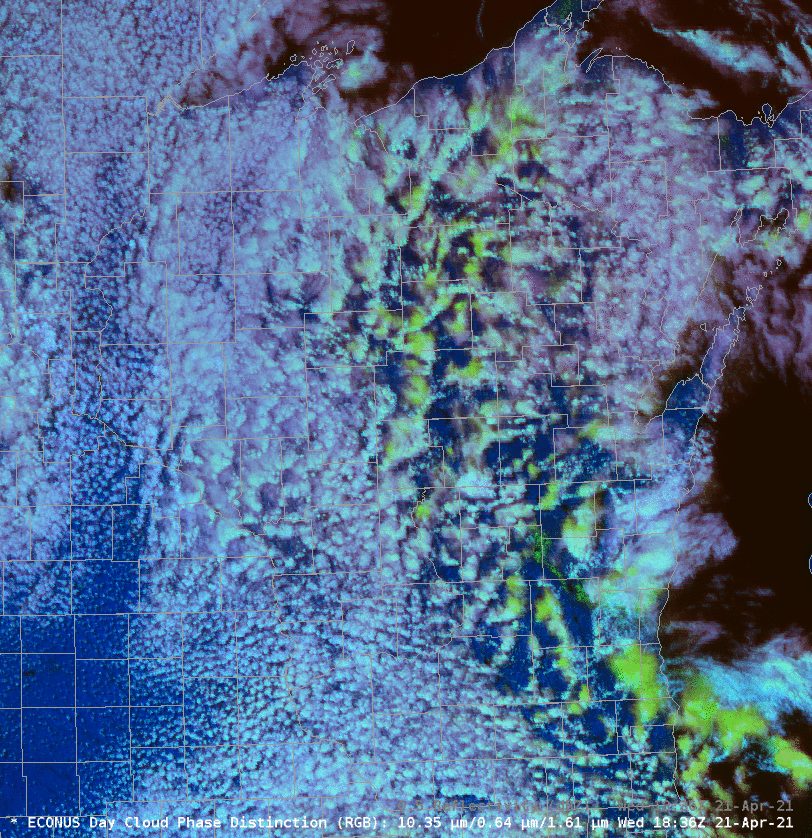
[ Archive ]

 |
CIMSS-NOAA Weekly Report [ Archive ] |
 |
CIMSS AND ASPB WEEKLY HIGHLIGHTS FOR THE WEEK ENDING APRIL 23, 2021
PRODUCTS AND APPLICATIONS:
Forecast impact of polar winds continues to be positive: A presentation by the (UK) MetOffice at the 15th International Winds Workshop, 12-16 April 2021, demonstrated that the polar winds products from VIIRS, MODIS, and AVHRR continue to have a positive impact in numerical weather prediction (NWP). While the total impact of the polar winds is small because of the comparatively small number of observations (figure below, left), the per observation impact is large (figure, right). Note: FSO is the sensitivity of NWP forecasts to individual observations or observation types. It provides a scalar measure of the proportion of forecast error due to the assimilation of some set of observations in terms of the 24-hour total energy norm. (J. Key, E/RA2, 608-263-2605, jeff.key@noaa.gov; D. Santek, R. Dworak, S. Wanzong, CIMSS)
 (Click image to enlarge)
(Click image to enlarge)
Figure: Left: The relative total impact (forecast sensitivity) of various observations and observation types, including the polar winds from VIIRS, AVHRR, and MODIS (AMV_AVHRR, AMV_VIIRS, AMV_MODIS). Right: The impact per observation (forecast sensitivity).
AWARDS AND RECOGNITION:
PUBLICATIONS:
WORKSHOPS, CONFERENCES, AND MEETINGS:
TRAINING AND EDUCATION:
NOAA/CIMSS ProbSevere training for WFO Glasgow: Scott Lindstrom from the Cooperative Institute for Meteorological Satellite Studies (CIMSS) gave a training presentation on NOAA/CIMSS ProbSevere to the Glasgow Montana forecast office (WFO GGW). This 30-minute presentation, derived from the Virtual Institute for Satellite Integration Training (VISIT) presentation on the product, was part of the office's Spring Convective Training event and was coordinated with Thomas Clemmons, the Science and Observation Officer (SOO) at the office. (Scott Lindstrom, CIMSS, 608 263 4425)
ACCAP VAWS Webinar including CIMSS Products: Scott Lindstrom from the Cooperative Institute for Meteorological Satellite Studies (CIMSS) presented at a Virtual Alaska Weather Symposium (VAWS) talk (managed by the Alaska Center for Climate Assessment and Policy (ACCAP), https://uaf-accap.org). The Symposium topic was Aviation Tools for Alaska. Two CIMSS-developed products were discussed: GOES-17 Instrument Flight Rule (IFR) Probability fields, which fields recently completed a Research-to-Operations transition, and which fields were developed by Mike Pavolonis and Corey Calvert, CIMSS. IFR Probability fields were recently expanded to include the Alaska domain (as shown at the CIMSS 'Fog Blog': https://fusedfog.ssec.wisc.edu); and Turbulence Probability Fields, developed by Tony Wimmers, CIMSS, and available here: https://cimss.ssec.wisc.edu/turbulence. The presentation was joint with Y.J. Noh from the Cooperative Institute for Research in the Atmosphere (CIRA) who discussed Satellite-detected three-dimensional cloud structures. A recording is available here: https://uaf-accap.org/event/vaws-april2021/. (S. Lindstrom, CIMSS, 608 263 4425; M. Pavolonis NOAA/STAR; C. Calvert, CIMSS; T. Wimmers, CIMSS)
CIMSS Training at WFO Honolulu: Scott Lindstrom from the Cooperative Institute for Meteorological Satellite Studies (CIMSS) presented (remotely) a two-hour training session to the Forecast Office in Honolulu, at the request of Eric Lau, Pacific Region Headquarters, and Ashley Evans, Meteorologist-in-Charge (MIC) at WFO Honolulu. Topics included a refresher on the uses of GOES-17 and Himawari-8 band imagery, including information on synthetic GOES-17 water vapor infrared imagery to supplement imagery lost because of the Loop Heat Pipe malfunction, Direct-Broadcast imagery and its uses, the Advanced Dvorak Technique (ADT) and Satellite Consensus (SATCON) from the CIMSS Tropical Website, Synthetic Aperture Radar (SAR) imagery, and Turbulence Probability fields. The training recording and PowerPoints were made available to the WFO HNL Office for forecasters who were unable to attend because of staffing. (Scott Lindstrom, CIMSS, 608 263 4425)
MEDIA AND OUTREACH:
CIMSS Virtual Science Fair featured in NOAA's 2020 Education Accomplishment Report: NOAA's 2020 Education Accomplishment Report published this week includes a spotlight on the annual Virtual Science Fair coordinated by NOAA's Cooperative Institute for Meteorological Satellite Studies (CIMSS) where students apply satellite data in research projects of their own design. See page 15 of https://www.noaa.gov/sites/default/files/atoms/files/Fiscal_Year_2020_NOAA_Education_Accomplishment_Report.pdf. (M. Mooney, CIMSS, margaret.mooney@ssec.wisc.edu)
SSEC and CIMSS Scientists in the News: Scientists at the University of Wisconsin-Madison (UW) Space Science and Engineering Center (SSEC) and the Cooperative Institute for Meteorological Satellite Studies (CIMSS) provide expert interviews, imagery and case studies to promote science. This week: 1) CIMSS Satellite Blog contributors Scott Bachmeier and Scott Lindstrom published case studies on "Showers over Wisconsin as viewed by GOES-16 Day Cloud Phase Distinction and Radar" (Apr. 21), "Subtropical Storm Potira off the coast of Brazil" (Apr. 20-22), and "Rapid intensification of Super Typhoon Surigae" (Apr. 16-17). Read more: https://cimss.ssec.wisc.edu/satellite-blog/. (J. Phillips, SSEC, 608-262-8164, S. Lindstrom, CIMSS, S. Bachmeier, CIMSS)
 (Click image to enlarge)
(Click image to enlarge)
Figure: Showers over Wisconsin as viewed by GOES-16 Day Cloud Phase Distinction and Radar. Read more: https://cimss.ssec.wisc.edu/satellite-blog/archives/40714. Credit: CIMSS.
 (Click image to enlarge)
(Click image to enlarge)
Figure: One-minute, GOES-16 visible images showed the circulation of Subtropical Storm Potira off the southeast coast of Brazil on Apr. 20, 2021. Read more: https://cimss.ssec.wisc.edu/satellite-blog/archives/40705. Credit: CIMSS, Brazil Centro de Hidrografia da Marinha.
OTHER:
| Archived Weeklies Page | Submit a report item |